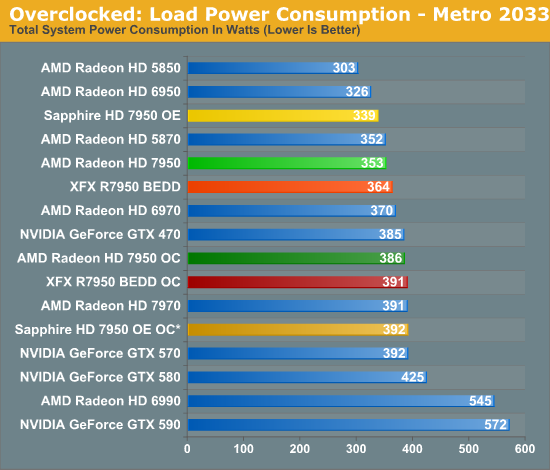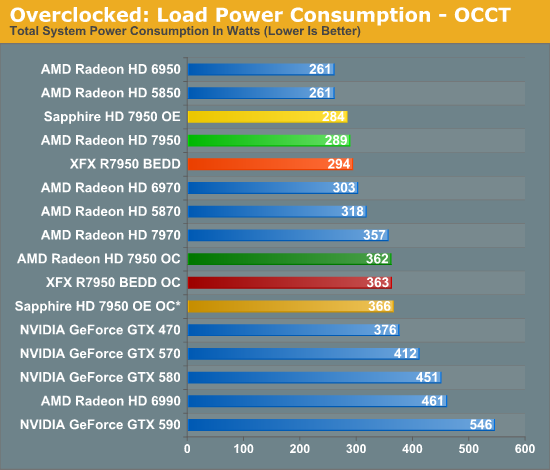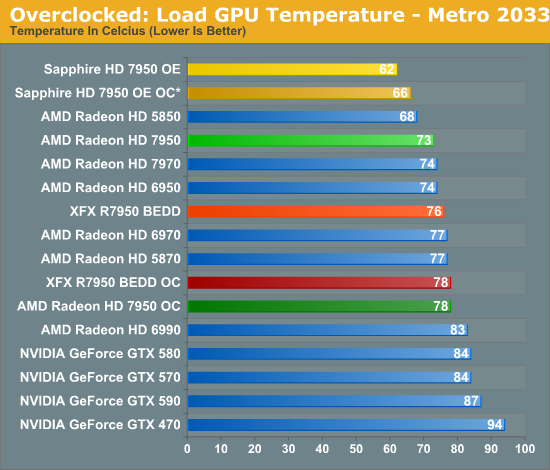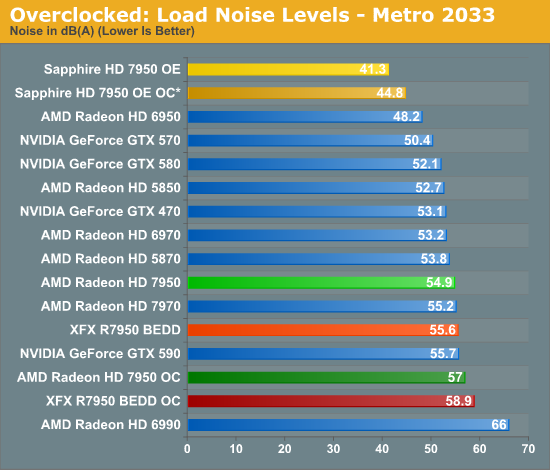AMD Radeon HD 7950 Review Feat. Sapphire & XFX: Sewing Up The High-End Market
by Ryan Smith on January 31, 2012 9:02 AM ESTOverclocking: Power, Temp, & Noise
In their marketing materials AMD is heavily pushing overclocking, and they have good reason to. With the 7970 we’ve established that Tahiti has quite a bit of overclocking headroom, and as the 7950 is clocked lower by default this opens up that headroom even further. Realistically AMD’s binning process means that the best clocking Tahiti GPUs are going to be allocated to the 7970 unless they have failed shaders, but even with that there’s quite a bit of potential on paper.
As with overclocking the 7970, our goal overclocking the 7950 is to see how much you can get for free; that is without any voltage adjustments. AMD’s reference PCBs are not particularly overbuilt for overclocking—cards like that will come later—so sticking to the reference voltage is the safest option, not to mention the easiest. With the 7970 we were able to get 200MHz (22%) overclocks without any voltage adjustment, and we’re hoping for the same out of the 7950.
With that said, we quickly ran into a wall on one card: the Sapphire 7950. Sapphire’s low VID of 0.993v may be great for temperature and noise at stock, but it’s not doing overclocking any favors. We only hit 950MHz at that voltage. As the Sapphire was the odd man out—every other card was at 1.093v—we did end up overvolting the Sapphire to 1.093v to see what it was capable of when put on similar footing as the rest of our cards.
After bringing up the voltage of our Sapphire card, all of our 7950s ended up overclocking to very similar levels. Our Sapphire and AMD cards topped out at 1025MHz core, a 225MHz (28%) overclock over a stock 7950 and a 125MHz (14%) overclock over the Sapphire’s factory overclock, while our XFX card reached 1050MHz, a 150MHz (17%) overclock beyond XFX’s factory overclock. Meanwhile the memory clocks on all of our cards topped out at 5.8GHz, beyond which we’d start seeing performance regressions from error correction on the memory bus.
| Radeon HD 7950 Overclocking | |||||
| AMD Radeon HD 7950 | Sapphire HD 7950 Overclock Edition | XFX R7950 BEDD | |||
| Shipping Core Clock | 800MHz | 900MHz | 900MHz | ||
| Shipping Memory Clock | 5GHz | 5GHz | 5.5GHz | ||
| Shipping Voltage | 1.093v | 0.993v | 1.093v | ||
| Overclock Core Clock | 1025MHz | 1025MHz | 1050MHz | ||
| Overclock Memory Clock | 5.8GHz | 5.8GHz | 5.8GHz | ||
| Overclock Voltage | 1.093v | 1.093v | 1.093v | ||
As you can imagine, with such similar overclocks, gaming performance on all 4 cards ended up being very similar. So we’ll get to gaming performance in a minute, while we’ll start with power, temperature, & noise.


Even though we’re not increasing the voltage on our AMD and XFX cards, merely overclocking them and raising the PowerTune limit to avoid throttling does drive the power consumption up. As is typical with heavily overclocked cards, overclocking quickly drives up power consumption and the 7950s are no exception. After overclocking power consumption is almost identical to the stock 7970, so while you can get 7970 performance you still need to pay the price with 7970 power consumption. Meanwhile it’s interesting to note that even with the extra 0.1v we’ve given the Sapphire card its final power consumption is only ever so slightly higher than the other 7950s, proving that voltage is the great equalizer in this case.


With the increase in power comes an increase in temperatures. The Sapphire card still does very well here staying in the low 70s even under OCCT, while the reference and XFX cards hit the high 70s under Metro and mid 80s under OCCT. As we’ve yet to really ascertain what the thermal limits are for Tahiti, it’s not clear whether there’s too much thermal headroom left for the GPU, particularly under OCCT.


Last but not least we have load noise. The Sapphire card is once more a stellar performer, and we still can’t get it above 50dB even with OCCT. Unfortunately the XFX 7950 BEDD has its biggest fallout yet—it may be able to overclock well, but at 64dB under OCCT the performance isn’t going to be worth the immense amount of noise it creates to move enough air to keep the GPU cool.










259 Comments
View All Comments
Ryan Smith - Tuesday, January 31, 2012 - link
Thanks. It looks like the culprit is the ShareThis widget we use. I'll have our developers look at it in the morning.Ananke - Tuesday, January 31, 2012 - link
This is a wonderful but too expensive product for the targeted market niche...It will not gain user base by April to attract software developers away from Kepler...Unless NVidia really executes bad /which they will not-internal source/, AMD will be positioned worthlessly by price/performance. Anyway, I admire AMD and I use their products, just their strategy has been lost recently.gnorgel - Tuesday, January 31, 2012 - link
It seems quite pointless to me to benchmark an OC 7950 vs a stock clocked 7970.Anyone who OCs a 7950 would OC his 7970 too. The interesting question is how these 2 OCed Cards perform against each other - this decides whether the the price difference is worth it or not.
kmmatney - Tuesday, January 31, 2012 - link
The best way to get performance per dollar is at this website:http://www.videocardbenchmark.net/gpu_list.php
and sort by "Video Card Value". Using this chart, I bought an HD6850 today, to replace my HD4890 (which is also near the top of the chart). It has enogh performance for me. The performance per dollar is dominated by AMD at the moment.
kmmatney - Tuesday, January 31, 2012 - link
My comment was supposed to be a response to another comment...LuxZg - Wednesday, February 1, 2012 - link
Now all that I wish for is direct comparison between Sapphire card and PowerColor PCS+ version.. Based on techPowerUp's review PowerColor could actually have even better cooling solution (noise/heat) which would really be amazing since Sapphire is already awesome. Make my wish come true Anand! :)And thanks for great review guys and showing off what a nice job AMD & Sapphire did with their new products...
ChosenOne - Wednesday, February 1, 2012 - link
Here is the link for the comparison chart between PowerColor and Sapphire.ChosenOne - Wednesday, February 1, 2012 - link
forgot the linkLuxZg - Thursday, February 2, 2012 - link
Thanks a lot! Seems that Sapphire has the upper hand after all, in both temperatures and noise..Th-z - Wednesday, February 1, 2012 - link
What GCN is able to do in the future is yet to been seen. They need a software ecosystem to support it, like what CUDA is having. In terms of gaming, aside from lower power consumption, the price isn't very attractive. I can see 7970 command a hefty premium, but the price of 7950 would fail AMD to capture some market share. The price they're trying to undercut is a single-GPU flagship part, which also carries a premium over 570, yet 7950 isn't a flagship part.In terms of gaming performance, 7950 is close to 580, which is close to 6970, yet it costs so much higher than 6970. It would be interesting to see how AMD is going to price their VLIW4 7800 and lower parts, because from the specs, they aren't much faster than 6000 series. This time, we probably won't see good performance jump with similar price points even after a major die shrink (remember they even skipped 32 nm). And I think the unnamed NVIDIA source said they was expecting more from 7970, which I think isn't a bluff, considered their Fermi debacle.